1. Retail Package - Installation
SONY DRU-530A DVD±RW recorder -
Page 1
 About
a month ago, Sony released onto the market it's very promising dual DVD
recorder, the DRU-530A. After a lot of waiting (due to some problems
in the post), our Sony drive finally arrived thanks to the official European
distributor. Eagerly, like mad scientists, we set forth, putting the
unit through its paces in our labs, and what follows is our appraisal of a
drive from which we expect a lot.
About
a month ago, Sony released onto the market it's very promising dual DVD
recorder, the DRU-530A. After a lot of waiting (due to some problems
in the post), our Sony drive finally arrived thanks to the official European
distributor. Eagerly, like mad scientists, we set forth, putting the
unit through its paces in our labs, and what follows is our appraisal of a
drive from which we expect a lot.
The recorder
is capable burning at speeds of 8x for DVD+R media, 4x for DVD+RW, 4x for
DVD-R and 2x for DVD-RW. The maximum allowed recording speeds for CD media
are 40x for CD-R and 24x for CD-RW.
Features
 The
DRU-530A recorder uses the Power-Burn feature to prevent buffer under-run errors.
This
feature includes Sanyo's well known Burn-Proof technology. Bellow are
presented the specifications for the drive, as they have been declared by
the manufacturer:
The
DRU-530A recorder uses the Power-Burn feature to prevent buffer under-run errors.
This
feature includes Sanyo's well known Burn-Proof technology. Bellow are
presented the specifications for the drive, as they have been declared by
the manufacturer:
Specifications
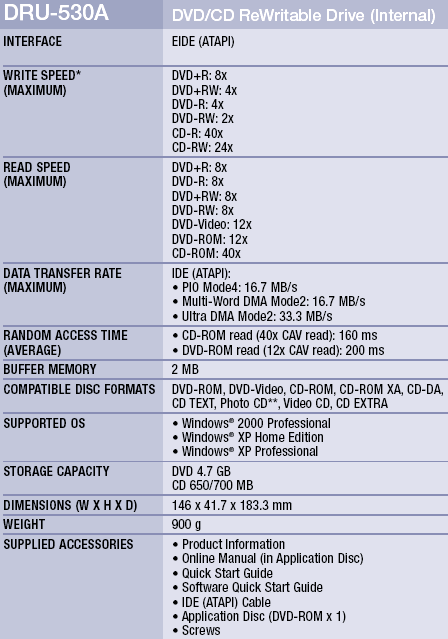

The drive has a 2MB buffer memory store and supports RAW DAO 96 writing
(CD). However the Sony drive does not support Mount Rainier,
nor does it read or write DVD-RAM media.
The drive uses the RPC II region control, allowing a user to change
the drive's region at most 4 times. For our tests, we set the region
code to 2 (Europe).
- The drive
 The
european retail package includes one DVD-ROM,
containing all the appropriate software for using the drive. Included is
the Record Now CD/DVD burning software from Sonic, DLA for packet writing and
MyDVD, also from
Sonic, for editing/authoring. Finally, there's Power DVD 5 for DVD playback,
and Musicmatch.
The
european retail package includes one DVD-ROM,
containing all the appropriate software for using the drive. Included is
the Record Now CD/DVD burning software from Sonic, DLA for packet writing and
MyDVD, also from
Sonic, for editing/authoring. Finally, there's Power DVD 5 for DVD playback,
and Musicmatch.
The warranty, a quick start guide, an IDE/ATAPI cable, sound card to recorder
connection cable and mounting screws complete the retail package contents.
The drive's front panel is colored off-white with a transparent perspex
cover on the tray door. On the tray door there are the DVD-R/RW logo on the
left, the
Compact Disc ReWritable logo in the center with the SONY brandname logo directly
above, and at right the DVD ReWritable
logo.
Below and at right, is the eject button, while a little to its left is the
activity/power led and emergency eject hole. The activity led turns orange
during playback and
blinking
orange
while
burning.


On the rear panel there are
the analogue and digital audio outputs (SPDIF), the IDE connector
and the power input.
Removing the screws and opening the drive's cover voids the drive's warranty.
For reference reasons, we post the following pictures. Click on the photo for
an enlarged view.


The drive is designed around the same
chipset as that used by the Optorite DD0401, manufactured
by Optorite.
In addition, the mainboard looks exactly the same.


- Installation
The SONY DRU-530A was connected to our test PC and was identified
as "DVD RW DRU-530A" under
WinXP. All tests were done with firmware revision v1.0c.
By the time this review goes to air, Sony Japan will have released the
new firmware (v1.0d), which is supposed to improve the writing performance
of the drive.

The following pages include the test results for the Sony DRU-530A drive
in comparison with two other dual DVD burners, the Optorite
DD0401 (an interesting comparison here since both drives use the same chipset)
and the LiteOn LDW-811S.
2. Data CD Reading Tests
SONY DRU-530A DVD±RW recorder - Page 2
Data CD Reading Tests
- Pressed CD (Click for
CDSpeed results)

In this pressed CD reading test, there wasn't much between the drives with
the LiteOn LDW-811S being marginally faster.
With a final speed of
40.37x, the SONY drive confirms the manufacturers specifications for 40x reading.
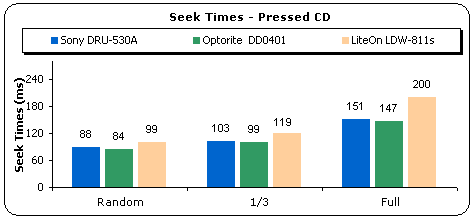
Again, the Sony and Optorite drives had similar times with the Sony being
slightly slower, and both being faster that the LiteOn, especially in the full
seek where the LiteOn needed 200ms for the Full seek.
- CD-R (Click for
CDSpeed results)

We made a copy of the previous pressed CD in order to test the drive's behavior
with a CD-R media. The resulting speeds are very close to those of the test
with the original pressed media from above. This is good, steady behavior
with different media from all three drives.
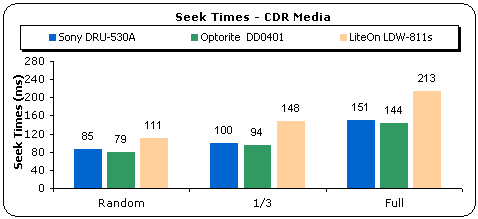
Here too, the seek times are almost identical to those of the same test
with the original media and again the Optorite drive returned a very slow
full seek time.
- ReWritable Media (Click for
CDSpeed results)
For the reading test
we used 24x High Speed rewritable media from Mitsubishi Chemicals.

Both the Sony and Optorite drives returned speeds very close to those of
the previous tests and both managed to reach 40x reading speed, something which
was not the case with the LiteOn which reached a final speed of 33.48x, however,
its specifications indicate 32x CAV with rewritable media. The times
for the Sony drive in general have been quite good and steady, and
the drive does not appear to be affected by the CD media type used.
3. CD Error Correction Tests
SONY DRU-530A DVD±RW recorder -
Page 3
Error Correction Tests
In the following tests we check the drive's behavior when reading
scratched / defective audio discs. The test discs used were the ABEX series
from ALMEDIO.
- ABEX TCD-721R

|
Errors
total
|
Num:
126635939
|
|
Errors
(Loudness) dB(A)
|
Num:
592873
|
Avg:
-38.2 dB(A)
|
Max:
-4.8 dB(A)
|
|
Error
Muting Samples
|
Num:
23162
|
Avg:
3338.1 Samples
|
Max:
3584 Samples
|
|
Skips
Samples
|
Num:
18
|
Avg:
1314.9 Samples
|
Max:
2939 Samples
|
|
Total
Test Result
|
45.2
points (out of 100.0 maximum)
|
The performance here is anything but good. The total error count is extremely
high, as are the average and maximum loudness error level at -38.2dB and -4.8dB
respectively. The skipped samples are also high and the final score of 45.2
is a good indication of just how badly the drive performed. Please note that
the drive was very slow in the ripping process of the test disc. This
indicates a general strategy of the Sony DRU-530A, to lower the reading speed
when the condition of the disc is bad. Although this strategy could be legitimate
in some cases offering accurate results, it turns out to be ineffective with
heavily scratched discs.
- ABEX TCD-726

|
Errors total
|
Num:
11145
|
|
Errors (Loudness) dB(A)
|
Num:
48
|
Avg:
-38.2 dB(A)
|
Max:
-23.3 dB(A)
|
|
Error Muting Samples
|
Num:
26
|
Avg:
1.0 Samples
|
Max:
0 Samples
|
|
Skips Samples
|
Num:
0
|
Avg:
0 Samples
|
Max:
0 Samples
|
|
Total Test Result
|
89.2
points (out of 100.0 maximum)
|
The Abex TCD-726 test disc is much easier for drives in general to read.
While the SONY DRU-530A managed to do better this time, the score which is
a good one, isn't as good as we have seen from most drives where 100.0 is the
norm, especially for a good drive. Strangely enough, the results for these
two ABEX disc tests for the Optorite drive yielded almost identical behavior
and scores. The explanation for was mentioned in the previous test. The drive
is able to accurately read scratched media, as far as the the
size of the scratch is lower than 1.500mm approximately.
- CD-Check Audio Test Disc
The CD-Check Test Disc is a very useful tool for evaluating the Sound Reproduction
/ Error correction capabilities of a CD player. The disc offers a signal combination
with disc error patterns to rate the drive's abilities to read music and reproduce
it completely. Five tracks on the disc contain a sequence of progressively
more difficult tests. These tracks are referred to as Check Level-1 through
Check Level-5.
The
tracks are reproduced (played) through a software multimedia player (i.e.
Windows Media Player). Each level is considered as passed, if the tone coming
out
from the speakers is smooth, continuous without interruptions, skipping or
looping. The higher the Check Level passed, the more reliable the sound reproduction
of the tested drive.
|
Error Level
|
1
|
2
|
3
|
4
|
5
|
|
SONY DRU-530A
|
5/5
|
5/5
|
5/5
|
5/5
|
5/5
|
The drive successfully passed all of the 5 check levels for this
test. Notice that the 5th check level has a scratch a size of 1.500 mm, and it
is difficult to be read with most drives.
Hence, we can say that the drive is exceptionally good at correcting
this type of defective disc.
- Summary
|
Test Disc
|
Reading Speed
|
Score
|
|
ABEX TCD-721R
|
Max
|
45.2
|
|
ABEX TCD-726
|
89.2
|
|
Average Score
|
67.2
|
So, summarizing we can say that the drive is very good at correcting badly
scratched discs, since it has been one of very few drives to read all five
check levels with the CD audio test disc. Nonetheless, the ABEX test results
weren't good and it will be interesting to see how the drive performs in the
remainder of our test. Up to now, the SONY and Optorite drives have performed
as though they were one and the same drive. It will be interesting to see if
this will carry through to the remainder of our test suite.
4. DVD Reading Tests
SONY DRU-530A
DVD±RW recorder -
Page 4
DVD reading tests
- Single Layer DVD-ROM (Click
for CDSpeed results)

In the DVD single layer read test, Sony and Optorite performed identically,
although not quite reaching 12x, while LiteOn was the fastest.

There's not a lot of difference in the seek times, but again the LiteOn drive
had the better seek times. Despite this however, the times for both the Sony
and Optorite drives are quite acceptable.
- Dual Layer PTP DVD-ROM (Click for
CDSpeed results)
The two layers of a PTP DVD-ROM disc are read sequentially with the drive
starting the read process from the inner tracks on the disc, which is the beginning
of each layer,
and progressing outwards towards the outer tracks for each layer.

The pattern continues. Not a lot of difference amongst the drives.
So far, quite good times from all three drives.

Once more, the LiteOn drive was the fastest in the seek times,
and appears to be slightly faster as a DVD reader.
- Dual Layer OTP DVD-ROM
 The
first layer of an OTP dual layer DVD-ROM is read exactly the same way as the
first layer of the PTP disc we tested previously. The difference here is the
reading strategy
of the second layer on the disc. The beginning of the second layer is located
in the outer part of the disc, so the drive starts reading from the outer tracks
inwards towards the inner tracks of the disc.
The
first layer of an OTP dual layer DVD-ROM is read exactly the same way as the
first layer of the PTP disc we tested previously. The difference here is the
reading strategy
of the second layer on the disc. The beginning of the second layer is located
in the outer part of the disc, so the drive starts reading from the outer tracks
inwards towards the inner tracks of the disc.

Sony's reading of the contents of this test disc is a little peculiar. Reading
starts at 3.48x and begins increasing in speed, but not for long before a
sudden
drop to just over 2x. And as suddenly as it dropped, it accelerates up to 4.22x
which is maintained up to near the end of reading. At the end, there is again
a sudden drop in speed.
This is not how a drive should perform with P-CAV. It should begin at a low
speed and steadily increase reaching the top speed which it then maintains up
to the end of the first layer (i.e. outer tracks). In the case of the dual layer
disc used here, this is then mirrored as the drive reads back towards the inner
tracks.
We have noticed this strange behavior previously, again with a SONY drive,
the Sony DRU-500A. Despite this, the test finished without reporting any errors.
- DVD Ripping Tests
We measured the DVD-Video ripping speed of the SONY DRU-530A using the
latest version of DVD Decrypter. The DVD Video title is the "Matrix" pressed
DVD-Video.

Sony proved very fast ripping the DVD title. Looking at the graph above,
the speed of 9373kb/s attained is a very high transfer rate. The LiteOn drive
is close behind, while the Optorite drive is a good deal slower.
- DVD Recordable / Rewritable reading Tests
The chart below shows the Nero CDSpeed average reading speed results with
DVD recordable and rewritable media.
It should be added that when we originally tested the drive, with
4x DVD+RW and 2x DVD-RW media, the resultant graphs showed a large drop in
speed towards the end of reading. We upgraded the firmware, where this anomaly
is remedied by changing from 8x CAV to 4x CLV for DVD+RW (4x), while for
DVD-RW, the 8x CAV reading was fixed.
In case of 2.4x DVD+RW, the drive read it at 8x CAV, with some reading problems
in the outer areas of the disc, however. Both sets of test graphs are given
in each case below.


5. DVD Error Correction Tests
SONY DRU-530A
DVD±RW recorder -
Page 5
DVD Error Correction
Tests
In the following
tests we examined the DVD reading capabilities of the SONY DRU-530A drive
with scratched / defective DVD media. For the tests we used CDVD
Benchmark and Nero CDSpeed. The reference test media
come
from
ALMEDIO.
- Single Layer media
ABEX TDR-821
This is a single sided, single layer DVD-ROM with a 4.7GB capacity, and its
surface has an artificial scratch of dimensions varying from 0.4 to 3.0 mm.
The following transfer rate picture comes from the CDVD Benchmark v1.21 transfer
rate test.

The drive read the 821 test disc without reporting any reading errors. There
were no speed deviations while reading the defective areas on the disc's surface.
The only setback is the rather slow reading speed (4x), especially when we
consider that other drives accelerate up to 12x with DVD-ROM media.
ABEX TDR-825
This is also a single sided, single layer DVD-ROM of 4.7GB capacity. The
data structure of the disc is exactly the same as that of the TDR-821, with
the difference that there are no scratches on the surface and instead
defective areas ranging in dimensions from 0.5 to 1.1 mm. There
are also fingerprints with height
between
65 and
75 micrometers.

The drive managed to read the defective areas on the disc without problems.
Once again the reading speed was slow at around 4x.
- Dual Layer media
ABEX TDR-841
This is an 8.5GB dual layer, single sided DVD-ROM disc with artificial scratches
of dimensions ranging from 0.4 to 3.0mm, on both layers.

Although the drive began normally, slowly accelerating from 4x up towards the
8x mark, a little after the half way point into the first defective region on
the disc, the speed dropped back down to 4x and kept at this speed up until
the end of the test. No read errors were reported.
ABEX TDR-845
This disc is a single sided, dual layer DVD-ROM disc with a capacity of 8.5GB.
The only difference between the TDR-845 and the TDR-841 is that the first includes
both defective areas and fingerprints. The dimensions of the defective areas
range from 0.5 to 1.1 mm and the fingerprints have height sized from 65 to 75
microns (micrometers).

Both layers were read at approximately 4x. The defective areas did not pose
a problem for the drive.
ABEX TDV-541
 The
TDV-541 is a single sided, dual layer DVD-VIDEO disc, with a capacity of 8.5GB.The
disc is based on the TDV-540 series which is designed for inspection
and adjustment of DVD-VIDEO players. The disc checks the layer switch operation
from layer 0 to layer 1 and also includes test pictures and test signals for
DVD sound files. The current TDV-541 also checks the error correcting
capabilities of the drive and includes scratches sized from 0.4 to 3.0 mm.
The
TDV-541 is a single sided, dual layer DVD-VIDEO disc, with a capacity of 8.5GB.The
disc is based on the TDV-540 series which is designed for inspection
and adjustment of DVD-VIDEO players. The disc checks the layer switch operation
from layer 0 to layer 1 and also includes test pictures and test signals for
DVD sound files. The current TDV-541 also checks the error correcting
capabilities of the drive and includes scratches sized from 0.4 to 3.0 mm.

The drive read the TDV-541 test disc without reporting any errors. However
we have a similar phenomenon here as we had when reading the TDA-841 ABEX
disc
where the speed accelerated and then dropped back to 4x, keeping that speed
up until the end. The disc was readable, however, with some problems in the
beginning of the second layer. Playing the disc through PowerDVD confirmed
that both layers were readable.
ABEX TDV-545
 The
TDV-545 disc is based on the TDV-540 series. It is a single sided, dual layer
Video/S-2 disc with a capacity of 8.5GB. The TDV-545 includes artificial
black dots on the disc's surface, sized from 0.4 to 1.0 mm. It also has 65
- 75 micrometer high fingerprints.
The
TDV-545 disc is based on the TDV-540 series. It is a single sided, dual layer
Video/S-2 disc with a capacity of 8.5GB. The TDV-545 includes artificial
black dots on the disc's surface, sized from 0.4 to 1.0 mm. It also has 65
- 75 micrometer high fingerprints.

This disc seems to be no problem for the Sony drive. The black
dots and fingerprints were bypassed without any effort.
6. Protected Disc Tests
SONY DRU-530A
DVD±RW recorder -
Page 6
Protected Disc
Tests
- Reading Tests
To create an image of the various protected titles onto a hard disk, we used
CloneCD v.4.3.1.9 software and the appropriate settings, depending on the protection
type of the inserted discs. Below are summarized the capabilities of the Sony
drive, according to CloneCD software. The summary below shows that the drive
supports writing of CD+G under RAW DAO:

The game titles we used for each protection scheme are given in the
table below:
Game Title
|
Protection Scheme
|
PSX "NBA Jam Extreme"
|
Lybcrypt
|
Serious Sam The Second Encounter v1.07
|
SafeDisc v.2.60.052
|
VRally II
|
SecuROM v.2
|
PSX Pressed Media
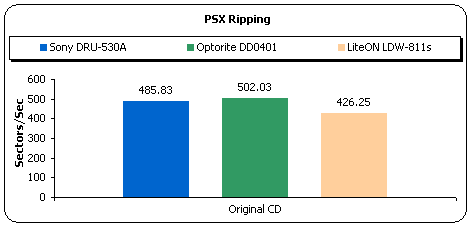
SafeDisc v.2
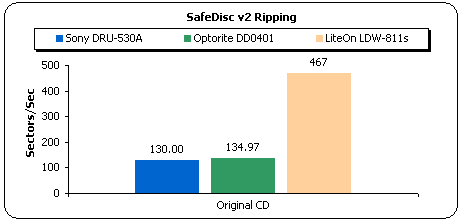
SecuROM v.2

Sony managed to rip the contents of all game titles tested. It gave acceptable
ripping performance although it was the slowest with SafeDisc and SecuRom
protected
games. However it was fast with PSX. It displayed similar performance, reporting
almost the same times as the Optorite drive.
- Writing Tests
The SONY DRU-530A supports the DAO-RAW writing mode.
For checking the drive's EFM correction status, we used 3 different game titles
with different SafeDisc 2 versions with the latest software patches installed.
After making the images of the various titles to the hard disk, we burned them
(maximum speed) with CloneCD. Two different discs were created for each
title; one with the "Amplify Weak Sectors" enabled and one more with
the
function disabled.
The table below shows the results of the attempted backups and whether
they ran (game installed / played normally), or not.
|
Drive |
Game Title |
SD2 Build |
Settings |
|
Amplify Weak Sectors On |
Amplify Weak Sectors Off |
|
SONY DRU-530A |
Max Payne |
v2.51.020 |
No |
Yes |
|
Serious Sam - The Second Encounter
v1.07
|
v.2.60.052 |
No |
Yes |
The Sims Unleashed |
v.2.8 |
No |
Yes |
The Sims Superstar |
v2.9 |
No |
No |
7. CD-DA - DAE Tests
SONY DRU-530A
DVD±RW recorder -
Page 7
DAE Tests
- Pressed and CDR AudioCD results
The SONY DRU-530A uses 40x CAV reading strategy for CD-Audio reading.
Below is the resultant output from the CDSpeed transfer rate test with a pressed
audio CD.
 According
to Nero CDSpeed, the average reading speed was 30.32x, while the reported seek
times were rather good. This test confirmed the drive's 40x reading speed reaching
a final speed of 40.11x.
According
to Nero CDSpeed, the average reading speed was 30.32x, while the reported seek
times were rather good. This test confirmed the drive's 40x reading speed reaching
a final speed of 40.11x.

We ripped the contents of the same audio disc to our hard disk, using the
CDDAE software. The average ripping speed (burst mode) of
27.6x, was slow. Notice that LiteOn had 39.9x.

The same pressed audio disc was copied onto a CD-R and was
read again with CDspeed. Once again Sony was the slowest and LiteOn the fastest.
- Advanced DAE Quality

In the Nero CD Speed Advanced DAE test, the Sony drive returned
an average speed of 28.51x, which is acceptable performance, and a quality score
of 100. CDSpeed reports that the drive can read Leadin,
Leadout, Cd Text and Subchannel Data.
- Support of 90/99mins AudioCDs
Sony failed to rip the full contents of our 90/99min test discs. We tried
to playback the discs, using Media Player, but the discs were readable up to
the 80th minute.
- Reading/Ripping Protected AudioCDs
For the test procedure we used two audio discs with different
audio protection schemes. We tested for both recognition and
ripping to the hard disk. The software used was Exact Audio Copy.
* Pressed Audio disc protected by Sony Key2Audio (Celine
Dion - New Day
Has Come)
* Pressed Audio disc protected by Cactus Data Shield 200 (Natalie
Imbruglia - White Lilies Island)
|
|
Key2Audio |
CDS200 |
|
EAC |
SONY DRU-530A
|
OK
|
Recognized the disc but cannot rip
or play the contents
|
Optorite DD0401
|
OK
|
Recognized the disc .Ripped and played
all tracks on the disc except the first.
|
LiteOn LDW-811S
|
OK
|
OK
|
The SONY DRU-530A performed well with our Key2Audio disc, which it managed
to read and rip. This wasn't the case with our other audio CD, with CDS200 protection,
where the disc was recognized by the Sony drive, but unfortunately it could
neither rip or play the contents of the specific disc. This was also the case
with the Optorite drive, while the LiteOn managed to rip and play both discs.
8. CD Recording Tests
SONY DRU-530A
DVD±RW recorder - Page
8
CD Recording Tests
- CD-R Writing Tests
The SONY DRU-530A supports 4x, 8x, 16x, 24x, 32x and 40x CAV
writing speeds. Below you can see the CDSpeed writing simulation graph with
Taiyo Yuden
48x CD-R
media.
 The
writing process began at 18.23x and finished at 41.19x reporting an average
recording speed of 31.91x. According to this, the manufacturer's specification
of 40x recording is confirmed.
The
writing process began at 18.23x and finished at 41.19x reporting an average
recording speed of 31.91x. According to this, the manufacturer's specification
of 40x recording is confirmed.

- Recording Times

We created an 80min data compilation with Nero Burning Rom and recorded it
on a 700MB disc. The drive's time was 3:13 minutes, with 40x
writing speed selected. The performance is good for 40x recording speed. LiteOn
was faster with only 2 seconds difference while Optorite needed 13 seconds more
to complete the task.
Below are the best writing times For Sony DRU-530A drive at 4x, 8x, 16x,
24x, 32x and 40x with a Taiyo Yuden media.

In the following graph you can see the recording times with
various media brands. We selected the maximum speed (40x) for all the recorded
discs, although the drive lowered this speed to 24x or even less, with Mam-E
and Creation media:

- CD-RW Writing Tests
 The
SONY DRU-530A supports 24x P-CAV maximum rewriting speed,
with Ultra Speed rewritable media. Below
are the results from the CDSpeed writing simulation test with blank
24x US-RW media from Mitsubishi Chemicals.
The
SONY DRU-530A supports 24x P-CAV maximum rewriting speed,
with Ultra Speed rewritable media. Below
are the results from the CDSpeed writing simulation test with blank
24x US-RW media from Mitsubishi Chemicals.
The test once again confirmed the drives specifications for 24x rewriting.
The burning procedure started at 18.34x and finished at 24.03x having an average
speed of 23.43x.

We also used Nero Burning Rom software to burn a data disc
using 24x US-RW media from Mitsubishi Chemicals. The data compilation, which
we burned, had a size of 651 MB. The duration of the recording process was 3:44 minutes.
Just for comparison, we provide the rewriting time of the Sony
drive against those of the Optorite and LiteOn.

- Packet Writing Tests
Using InCD and Mitsubishi Chemicals 24x US-RW media for all Packet Writing
tests, quick format took 37sec. The formatted disc had
530mbs of free space. We copied a 403 MB file (412.822 KB) from Hard Disk
(on the same PC as the recorder) to the formatted RW media through Windows
explorer (drag and drop).
Operation
|
Duration
|
Average speed
|
Read
|
3:38 min
|
12.6X
|
Write
|
3:38 min
|
12.6X
|
- Other features
|
Overburning
|
Up to 94 min
|
|
CD text reading/writing
|
Yes
|
9. 3T Jitter Tests - Page 1
SONY DRU-530A
DVD±RW recorder -
Page 9
Writing Quality Tests - 3T Jitter Tests
On an 80min 48X CD-R disc from Taiyo Yuden we burned the same AudioCD
project at 4x, 8x, 16x, 24x, 32x and 40x. The 3T
Pit & Land Jitter graphs are presented here.
- 3T Pit results
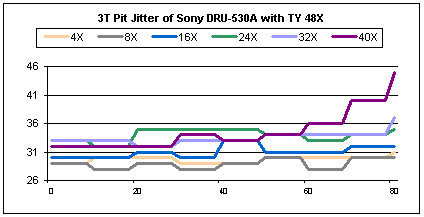
Looking at the graph above, we can conclude that generally the Sony drive performed
well, keeping the jitter levels below the Redbook limit of 35ns at all speeds
except for 40x, where it reached a fairly high level at around 45ns, and 32x
which reached 37ns at the very end.
The average
3T Pit Jitter values for all recording speeds are illustrated in the following
table.

The average Pit jitter for recording speeds of 24x and over is
satisfactory, and very good for those below.
- 3T Land results

At 8x and 16x recording speeds, the performance is good. 4x can also be considered
acceptable even though it oversteps the mark with 36ns. At all other speeds,
the Land jitter performance is not good reaching a high of 52ns at 40x speed.
The following average values graph confirms the unacceptable levels at the
higher speeds. At such levels, the possibility of errors or even audible clicks
during playback
is increased.

|
Recording Speed
|
Average 3T Pit Jitter (ns)
|
Average 3T Land Jitter (ns)
|
> 35ns
|
Max 3T jitter values (ns)
|
|
4X
|
29.66 |
33.98 |
Yes |
31 Pit, 36 Land
|
|
8X
|
28.90 |
29.63 |
No |
30 Pit, 31 Land
|
|
16X
|
31.02 |
32.78 |
No |
33 Pit, 34 Land
|
24X
|
33.90 |
37.80 |
Yes |
35 Pit, 40 Land
|
32X
|
33.34 |
40.37 |
Yes |
37 Pit, 45 Land
|
40X
|
34.39 |
42.73 |
Yes |
45 Pit, 52 Land
|
- Summary
With the SONY DRU-530A, the pattern that is obvious is that at higher recording
speeds we have higher jitter levels, and with the case of land jitter, the levels
are unacceptable.
Right after we finished the measurements, Sony announced a new firmware upgrade,
which according to the manufacturer, improves the writing quality of the unit.
You can download the latest firmware HERE
The following page where we check the jitter levels produced on various
manufacturers discs, should give a better indication
of the
writing
quality
level
of
the
drive.
10. 3T Jitter Tests - Page 2
SONY DRU-530A
DVD±RW recorder -
Page 10
Writing Quality Tests - 3T Jitter Tests
The same Nero compilation used in the previous jitter tests was used once again,
this time with media from different brands. The recording speed was the maximum
40x in all cases. The following graphs show the 3T Pit & Land Jitter results.
- 3T Pit results

With all the media brands used with the Sony drive, the jitter levels were
generally good. Only SKC media and to some extent Memorex, produced levels above
the 35ns limit.
The average 3T Jitter values for all manufacturers discs are illustrated in
the following graph.

- 3T Land results
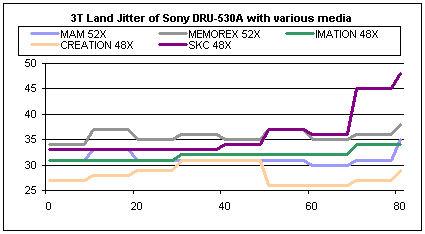
Once again all the media brands gave low land values, with the exception of
SKC media which near the end, where writing takes place on the outer tracks
of the disc, we had high jitter values and Memorex media which hovered just
above the limit throughout.
The average values presented below illustrates the drives recording ability.
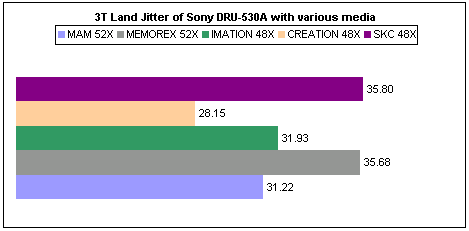
|
Recording Speed
|
Average 3T Pit Jitter (ns)
|
Average 3T Land Jitter (ns)
|
> 35ns
|
Max 3T jitter values (ns)
|
Mam 52X |
28.39 |
31.22 |
No |
34 Pit, 35 Land |
Memorex 52X |
33.34 |
35.68 |
Yes |
37 Pit, 38 Land |
Imation 48X |
31.71 |
31.93 |
No |
35 Pit, 34 Land |
Creation 48X |
27.78 |
28.15 |
No |
30 Pit, 31 Land |
SKC 48X |
31.95 |
35.80 |
Yes |
40 Pit, 48 Land |
- Summary
Generally, from this series of tests, we can conclude that the drive is a
good CD recorder although, we had expected slightly better results. MAM, Imation
and Creation discs gave the best results, but note that they were not recorded
at full 40x.
Again we provide the link to the firmware upgrade for the Sony DRU-530A which
may offer better performance here.
On the following page we check the C1 and C2 error rates for the same discs.
These are the last of the quality tests.
11. C1 / C2 Error Measurements
SONY DRU-530A
DVD±RW recorder -
Page 11
Writing Quality Tests - C1 / C2 Error Measurements
The C1 / C2 error rate was measured for the recorded discs burned during the
previous writing tests (jitter). The software used was UMDoctor Pro II, and
the reader was the Optorite DD0203 drive.
- Taiyo Yuden 48x recorded at 4x

- Taiyo Yuden 48x recorded at 8x
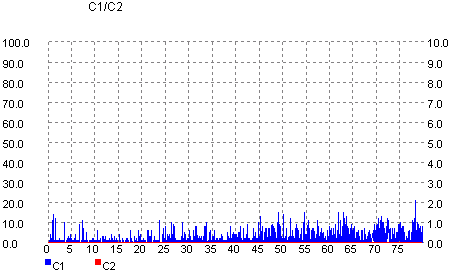
- Taiyo Yuden 48x recorded at 16x

- Taiyo Yuden 48x recorded at 24x

- Taiyo Yuden 48x recorded at 32x

- Taiyo Yuden 48x recorded at 40x
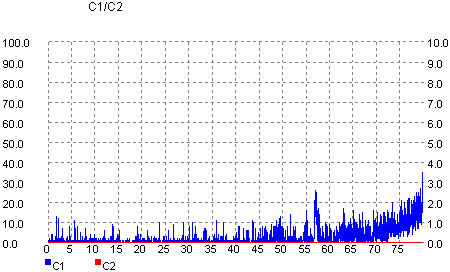
- Memorex 52x recorded at 40x

-
Mam 52x recorded at 40x (dropped to 24x)

-
Creation 48x recorded at 40x (dropped to 24x)


-
CMC Magnetics 48x recorded at 40x
Below is presented information on the CD-R
media used in this test.
The results are good with all media brands. The C1 levels are all quite
low and consistent in their levels. Generally the drive
performed well.
The SONY DRU-530A supports DVD-R/RW and DVD+R/RW writing. The maximum
supported speed for DVD+R is 8x (4x~8x Z-CLV), 4x CLV for DVD-R, 4x CLV
for
DVD+RW and 2x CLV for DVD-RW media.
Currently, only a few 8x certified DVD+R media are available on the market.
The supported 8x DVD+R media which we tested came from Mitsubishi Chemicals,
Taiyo Yuden and CMC Magnetics.
The drive supports speeds of 8x Z-CLV, 4x and 2.4x for DVD+R media. It started
the writing at 4.02x, maintaining this speed until the 1250MB address mark
on the
disc,
where
the
drive steps
up to
8x writing for the rest of the recording (hence Z-CLV). The average
speed is 6.88x.
Following are the same tests with DVD-R, DVD+RW and DVD-RW media. Supported
writing speeds for each type are 4x and 1x for DVD-R, 4x and 2.4x for DVD+RW,
and 2x and 1x for DVD-RW.
The best recording times are illustrated in the following table after burning
4315MB of data on various DVD±R, DVD±RW media, using the maximum
allowed writing speed for each disc. For
comparison, we
also include
the
writing
times for the
Optorite DD0401 and LiteOn DRW-811S drives.
All the drives had very good times and there was very little between them.
Only with DVD+R media is there a difference where the LiteOn drive
is noticeably faster. With all other media, the difference in times is negligible.
The following screen shots were taken from Nero, after successful
burnings. The
amount
of data
is the same for all the tests.
The table above presents the writing speeds, media name and media code for
the various
discs used.
For this test we copied a 403 MB file (412.822 KB) from the hard disk (on
the same PC as the recorder) to the formatted RW media through Windows explorer
(drag and drop).
The following screenshots show the PI/PO results for various DVD-/+R
and DVD-/+RW media, recorded with the SONY DRU-530A at the maximum allowable
speed.
The software used for the measurements was KProbe v1.1.28, the ECC was
set to 8 and the reading drive was the LiteOn LDW-811s. The specific methodology
is very dependent on the
drive
used as a reader, while the reliability of the PI/PO provided output is also
not technically confirmed. Hence as a result, we cannot safely come up
with conclusive results,
although we do make a comparison
of the drive's behavior
when using
various
DVD recordable/rewritable
media.
The recording discs used came from Mitsubishi
Chemicals, CMC Magnetics, Taiyo Yuden, N-Tech, Pioneer, Sentinel, TDK and Ritek.
Further details about each disc type are presented at the bottom of this page.
The media we used was by CMC Magnetics, 8x DVD-R certified.
Burning a 4.3GB DVD-Video with Nero Burning Rom confirmed the 8x writing speed,
although the duration of the task was increased (9:48min). This is due to
the 4-8x Z-CLV writing strategy used, instead of the 6-8x used by some competitive
drives:
Below are available all the media we burned with the upgraded DRU-530A. As
you can see the drive burned at 8x only with CMC magnetics media. On the other
side, the Nec-2500A had burned all the media below at 8x.
KPRobe v1.1.28 measurements will give us a picture of the drive's DVD writing
quality with DVD-R/-RW media.
The results are not any good since the PI/PO error rate is really high. The
test was performed twice with the same results. The DVD-R disc was unreadable.
In case of DVD-RW media recorded at 4x, the results are better than in the
previous case. However, readability was not very good as Nero CDSpeed reports.
Sony DRU-530A managed successfully to burn at 4x our DVD-RW media.
The PI/PO measurements were in acceptable levels and the output was playable.
However
we cannot say
the same for 8x DVD-R writing. We managed
to
burn only
one
media brand at 8x, since the other brands were not allowed recording at 8x
but at 4x. Also the output was not playable in PowerDVD. We tried twice to
burn different
DVD-R media but both times playback had problems. The first disc was completely
unplayable while the second one played just for the first few movie minutes.
This happened with all different DVD burners /players we tried.
We were expecting a lot from this drive, much better performance and we were
certainly expecting to see it rank among the best. Unfortunately this was not
the case. While it can be regarded as a good drive, it certainly isn't much
more than that. The reading speeds for CD/DVD were good and the seek times were
acceptable for CD media although they could be better with DVD media.
The behavior with our Audio CD's during the error correction tests was a little
strange. Although the "Check Audio Test Disc" CD was played flawlessly
reading up to the 5th level (1,500mm scratch - something we have seen
only from the best drives),
the TCD-721R test disc produced some of the worst levels we have seen. The
other TCD-726, which is a much easier test disc to read, while giving a good
score,
was not indicative of a top drive. All of our test DVD's played successfully
on the drive without any errors to be reported. The drive simply ignored
the
defective areas on those discs.
With protected disc backups, the drive could not make SafeDisc v2.9 working
backups (most recorders have problems with this version), although versions
v2.8 and earlier are supported.The drive was in most instances fast with ripping
the game titles we tried, apart from Safedisc protected titles.
DAE was also a bit of a disappointment, where we had expected the drive to
be faster. Unfortunately the drive didn't manage to play/rip the CDS200 protected
Audio CD.
From the writing tests we did, we generally saw good performance, with low
recording times and the tests confirmed the manufacturers specifications. And
while only achieving 94min overburning, this is quite acceptable.
As far as CD writing quality is concerned, from the measurements that we did
with the various manufacturers media, it can be generally said that it is
good,
with low jitter values, although it did go over the limits especially at the
higher speeds. The C1 levels were good, while there were no C2 errors
reported.
With DVD recording, we would like the drive to be faster, since the 9:30 minutes
at 8x is not the best we have experienced. In addition, the Sony's DVD
writing quality is
not very good with almost every media type we trailed. The PI/PO measurements
revealed high levels.
The drive's price on the market is around $170~220. Maybe with a bit of searching
you may be able to find lower prices. At this price however, we would say that
it is one of the more expensive drives, especially when you consider that you
can find something like the Optorite DD0401 which is pretty much the same drive,
for a good deal less.
One final note, for anyone that does end up buying this drive, definitely upgrade
the firmware.
* After upgrading the drive with the latest firmware, the recording speed
for DVD-R media was increased from 4x to 8x. However there are compatibility
issues that should be solved.